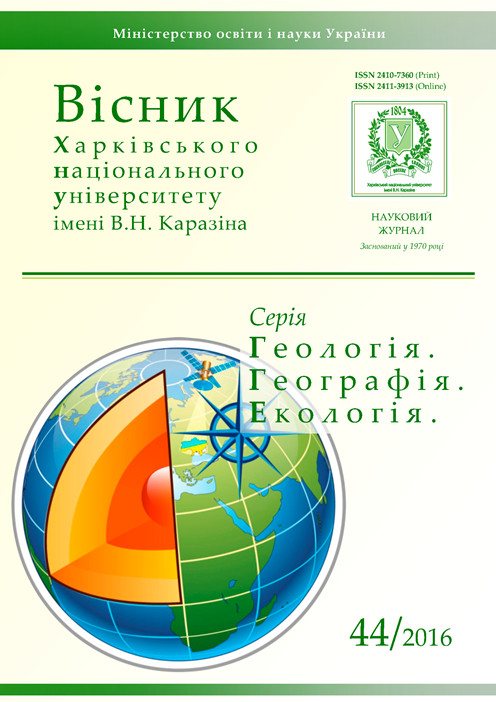Analysis of the two-level urbogeosystems by GIS-tools
Abstract
The authors provide the urban geosystem concept both within some details of its theory, and with a few examples of its practical applications. Our paper recognizes this conceptual research approach concerning the GIS-tools of urban data geoprocessing, modeling and visualizing on the base of either O-D urban data, or data extracted by LiDAR-technology remote sensing. A strong spatial aspect of the urban research implies the GIS tools involvement that has been considered in details. Two levels of the urban geosystem entity have been introduced - an external level (a set of cities), and an internal one (a set of parts for an individual city). To present urban data reliability it should be coupled with a powerful GIS-technology in the strategic urban study goal: various data integration and visualization. It is accepted that the spatial hierarchy of urban geosystem can be abstracted as three main constituents: a set of point objects, containing attributes of a single city; a set of line objects, indicating the interaction patterns that exist among the cities; a set of areas, indicating the city impact on the territories nearby. Such urban geosystem understanding completely coincides with the GIS basic object outline of a point, a line and a polygon. The algorithmic modeling consequence, which unites the geographic “gravity” model and a GIS model of an urban geosystem, has been built within the introduced framework. The regional example of the external urban geosystem modeling has been introduced. As far as an internal urban geosystem is concerned, the approach introduced in the paper has been employed for this system’s architectural dynamic analysis. The GIS-interface and specialized original software functionality have shortly been considered in the mentioned respect of urban geosystem analysis. In addition, the analysis results obtained through LiDAR-technology and GIS-tools have been examined briefly.
Downloads
References
2. Isachenko, A.G. (2001). Ecologicheskaya geographiya Rossii. St. Petersburg: St. Petersburg University, 328.
3. Lihacheva, E.A. et al. (1996). Gorod - ekosystema. Moscow: IGRAN, 336.
4. Kostrikov, S.V. (2014). Geoinfomatsijne modelyuvanny prurodno-antropogennogo dovkillya. Naukova monographiya. Kharkiv. Vud-vo HNU, 484.
5. Kostrikov, S.V. (2014). Programne zabezpechennya GIS dlya LiDAR-technologii dustantsijnogo zonduvannya v tsilyah analizu urbogeosystem. Problemu bezperervnoi geographichnoi osvitu i kartographii. 19, 45-52.
6. Kostrikov, S.V., Chuev, O.S. (2015). Dvorivneva GIS-model dlya analyzu urbogeosystem. Region – 2015: Strategy of optimal development. Annual International Conference. Kharkiv, 20-22.
7. Chuev, O.S., Kostrikov, S.V. Otsinka cherez GIS-zasobu prostorovoi differentisatsii blagoustroyu mista yak funktsii urbogeosystemu (na prukladi mista Kharkiv. Chosopus socialjno-ekonomichnoi geographii. 18 (1). Kharkiv, 52-62.
8. Berkowitz, A.R., Nilon, C.H., Hollweg, K.S. (Eds). (2005). Understanding Urban Ecosystems: A New Frontier for Science and Education. New York: Springer-Verlag, 523.
9. Boyce, D., Williams, H. (2015). Forecasting Urban Travel: Past, Present and Future Cheltenham – Northhampton: EE Publishing, 639.
10. Bourne, L.S., Simmons, J.W. (Editors). (1978). Systems of Cities: Readings on Structure, Growth, and Policy. Oxford: Oxford University Press, 565.
11. Bourne, L.S. (1997). Polarities of Structure and Change in Urban Systems: A Canadian Example. 43, 339 -349.
12. Coffey, W.J., Shearmur, R.G. (1998). Factors and Correlates of Employment Growth in the Canadian Urban System, 1971-1991. Growth and Change, 29, 44-66.
13. Du, G.Q. (1997). A Study on the relationship of regional urbanization and socio-economic structure in China./ Annals of Japanese Association of Economical Geographers. 43, 151–164 (in Japanese with English abstract).
14. Friedmann, J. (1996). The world city hypothesis. Development and Change. 27 (1), 69–83.
15. Kostrikov, S., Sehida, K. Human geography with geographical information systems. Human Geography journal. 15 (2), 39-47.
16. Olivero, M. Yotov, Y. (2012). Dynamic gravity: endogenous country size and asset accumulation. Canadian Journal of Economics, 45 (1), 64–92.
17. Romano, M.E. (2004). Innovation in LiDAR processing technology. Photogrammetric Engineering Remote Sensing. 70, 1202-1206.
18. Sassen, S. (2001). The Global City: New York, London, Tokyo. Princeton: Princeton University Press, 480.
19. Simmons, J.W. (1978). The organization of the urban system. In: Bourne L.S., Simmons J.W. (eds), Systems of Cities: Readings on Structure, Growth, and Policy. Oxford: Oxford University Press, 61-69.
20. Taylor, G. (2007). Modelling and prediction of GPS availability with digital photogrammetry and LiDAR. International Journal of Geographical Information Science. 21 (1), 1–20.
21. Werlen, B. (2003). Society, Action and Space. NY-London: Psychology Press, 279.
22. Wong, C, Baker, M, Webb, B, Hincks, S., Schulze-Baing, A. (2015). Mapping policies and programmes: The use of GIS to communicate spatial relationships in England. Environment and Planning B: Planning & Design, 42(6), 1020-1039.
23. Zax, J. (1994). When is a move a Migration? Regional Science and Urban Economics, 24, 341-360.





